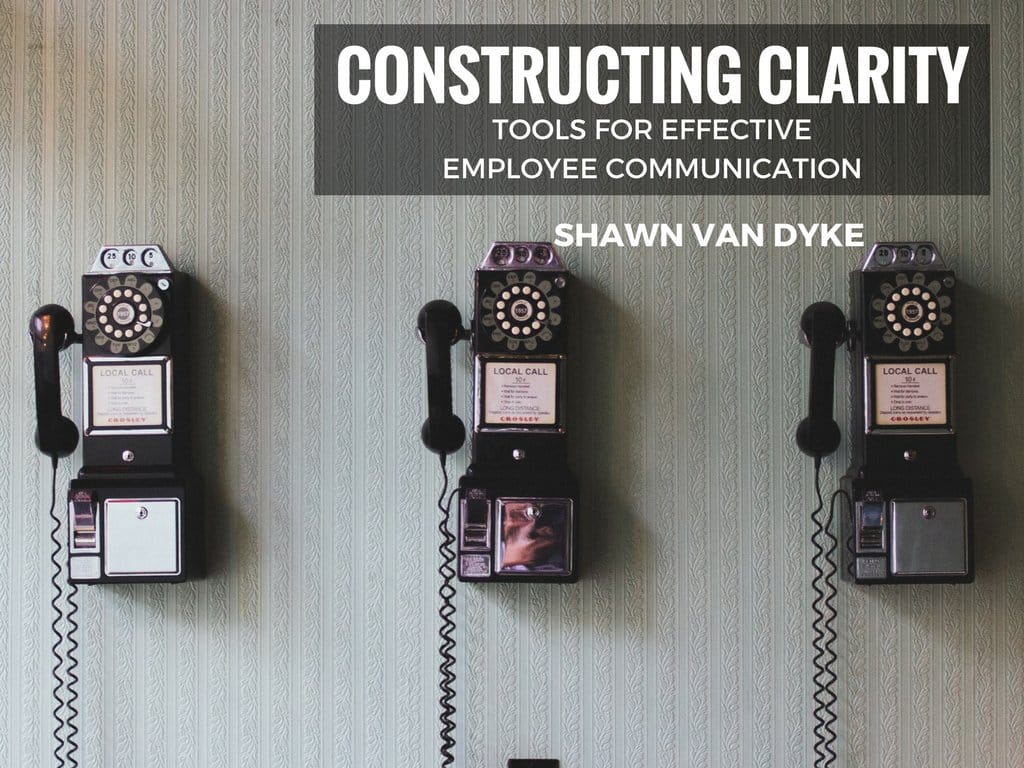Built to Build: Blog
Construction Employee Communication

Running a successful construction business requires more than technical proficiency with tools and the ability to do good work.
Establishing clear lines of communication with your construction employees enables them to operate more efficiently, empowers them to execute their jobs without delays, and ensures quality standards are met.
How a construction business owner communicates with employees within the company is just as important as the vision and mission of the company.
If your employees do not understand the way in which they are to communicate with you, each other, and your clients, then even the most comprehensive business plan will be of no use.
5 Tools for Effective Employee Communication
In this article on FineHomebuilding.com, I describe Five Tools for Effective Employee Communication.
TOOL #1:
JOB TITLES FOR YOUR CONSTRUCTION BUSINESS
The job titles you use in your construction company should clearly define the role each of your employees plays within your business. Although designing a job title may seem simplistic in nature, the lack of clearly defined job titles leads to ambiguity within your construction company.
A job title in and of itself is not enough to communicate the role.
Each job title should also have job description, a list of responsibilities, and the duties associated with it.
The job description is a one or two-sentence narrative summarizing the job. (This is what an employee would answer when that employee is asked, “What do you do?”
The responsibilities listed with each job title should cover a broad view of the management tasks that comes with that job.
The duties of each job title should list the technical tasks that a person with that title should be expected to perform on a day-to-day basis.
For example:
JOB TITLE: LEAD CARPENTER
Job Description:
The Lead Carpenter manages the day‐to‐day execution of his team members, project scope and schedule.
Responsibilities:
Planning and execution of project scopes, scheduling and managing project team(s) and company asset allocation to achieve company and project goals.
Duties:
- Task allocation to team members‐ Provides technical instruction to team members
- Problem solving
- Responsible for project record keeping
- Tool and Equipment support
- Decision making
- Communication with/between clients and Project Manager
- Direct Oversight of team members
- Expected to have a complete tool set‐up to complete any general carpentry task (specialty tools excluded)
With the job title set, the description clearly defined and the responsibilities and duties well-designed for that position, your employees can operate within that role with clarity. Having the positions within your company defined in this way has another benefit.
You will have the ability to gauge your employee’s performance at performing this job.
Designing the job titles for your employees is the first step in establishing clear lines of communication within your construction business.
Once you have defined what each position does, you must define how that job relates to the other positions within your business.
TOOL #2:
ORGANIZATIONAL CHART FOR YOUR CONSTRUCTION BUSINESS
Another effective tool in establishing clarity within your construction business is developing an Organizational Chart.
In his book, Predictable Success, Les McKeown details how your company’s Organizational Chart should be less of a visual representation of the hierarchy within your business and more a blueprint of your “decision-making machine.”
When everyone within your organization knows what everyone’s job is, then they will know exactly what to communicate and to whom.
Decisions get made faster with less information bleed than if these decisions were passed up the ‘chain of command.’
When decisions are made in a timely manner by well-informed people, then the quality and level of service to your clients can increase.
Another benefit of designing and advertising a well-defined Organizational Chart is that your employees can see the path of advancement within your construction company.
For example:
If John’s job title is Foreman, and he wants to become an Estimator within a couple years, then he can see on the ORG CHART that he may need to spend some time as a Superintendent or develop the skills listed under the Project Manager.
John is following the path laid out on the ORG CHART.
Defining job titles and designing an organizational chart are essential tools to establishing clear lines of communication with your employees.
The tools listed above tell your people what you expect them do and where they can expect to go.
Now that your people know what to do and where to go, they need to know how to do everything else.
TOOL #3:
THE EMPLOYEE HANDBOOK
Once you have designed the ‘decision-making machine’ – the ORG CHART, then you need to give your people the operations manual to maintain the machine.
The employee handbook should not only give your people the step-by-step process for every system within your company, but it should also explain your company’s policies.
The Employee Handbook does not need to contain every procedure for every task that your employees perform, but it should contain a description for every system and every policy that exists within your company.
Systems within an Employee Handbook:
- Timecard reporting
- Material Purchasing
- Design Procedures
- Safety Procedures
- Meeting/Communication Procedures
- Vacation/Time Off Requests
- Job Titles/Descriptions
- Organizational Chart
- Vision/Mission Statement and Core Values
Policies within an Employee Handbook:
- Safety
- Employee Benefits
- Use of Company Property (Tools)
- Company Purchasing (Credit Cards/Vendor Accounts)
- Side work
- Hiring Process/Evaluation Periods
- Employee Behavior
- Trade Secrets
- Drug Abuse
- Termination
The examples listed above are only a few examples of the contents of an Employee Handbook.
You should consult an attorney or Human Resource professional to make sure that your Employee Manual adheres to all federal, state, and local jurisdiction laws.
You should also consider your Employee Handbook to be a living document. Keep revising and adding to your Employee Handbook as you become aware of or develop new policies and procedures that will aid in communicating the information your employees need to know.
Design your Employee Handbook so that you can add to it easily, and issue revisions as needed.
And always make sure that you have a signature page that states that your employees have read the document and agree to adhere to the policies and procedures contained within.
The signature page will help you in the case of a legal dispute with a terminated employee.
TOOL #4:
PROJECT SCOPE and BUDGET
A MINI PROFIT AND LOSS STATEMENT
Each and every project that you perform has a price associated with it. This price is determined by the amount of labor, materials, and equipment you sell to your clients and the markup you apply to cover your overhead and produce a profit.
Understanding the relationship of price to costs, expenses, and profits is key to managing the performance of your business.
The proposals your clients accept in a given period of time determines the Total Revenue for your business.
If your employees understand how profit is made in your business, then they will make decisions that can positively affect those profits.
See this article for determining your profit margin.
Teach your employees, especially those in lead or management positions, how to manage the costs and expenses of the projects on which they work and how these things determine the success of the projects.
Every proposal is a miniature Profit and Loss Statement with estimated costs for labor, materials, and equipment. You employees need to know how much time they have to perform certain tasks. They need to know what the budget is for the materials used, and how best to utilize the equipment to meet the budget.
In his book, Ownership Thinking: How to End Entitlement and Create a Culture of Accountability, Purpose, and Profit, Brad Hams states,
“In the absence of information, people make stuff up.”
The fabrication of information by your employees is usually not malicious nor intentional in nature, but it happens nonetheless.
Inform your employees how the job was priced, the schedule for each of the phases of production, and the details of project scope. Ask for their input on these items and make the necessary adjustments in production to achieve the goal.
Do not make the mistake of selling a job and then asking your employees to perform the job without informing them of the scope and budget.
TOOL #5:
WRITING A MISSION STATEMENT
There is no better tool for effectively communicating with your employees than a thoughtful mission statement.
The problem with mission statements is that they are so many bad ones.
An effective mission statement is one that clearly communicates why you are in business.
Your mission statement should tell your customers why they should hire you and should tell your employees why they should work for you.
Crafting a great mission statement that clearly states your “why” to these two groups of people is not easy and will take several iterations to perfect.
But if you invest the time to develop your mission statement, then it will attract better clients and better employees.
There is no formula for writing a great mission statement, and there is no set rule about how long a mission statement should be.
But the shorter the better.
A great mission statement will be one that is concise, succinct, and easy to memorize.
If your employees cannot recite the mission statement from memory, then how can they live it out?
The shorter the mission statement, the more chance you have that your employees will memorize it.
If they will memorize it, then they can repeat it.
If they can repeat it, then they have a better chance to live it out.
When they live it out each day, then your company will be known for it.
Choose each word carefully for the greatest impact.
The ultimate job of any business owner is to lead people. The best place to start is with your employees.
If you create clear lines of communication within your organization, then you will achieve your goals faster and with less headaches along the way.
When you clearly communicate to your employees who they are supposed to be (Job Titles), where they can go (ORG CHART), what they are required to do (Employee Handbook), how they can be profitable (Project Scopes/Budgets), and why they are doing it (Mission Statement), then your efforts toward creating a world-class construction business will become a self-fulling prophecy.
If you want to streamline your construction business and DOUBLE your profits next month…
download my FREE book: The Paperwork Punch List

